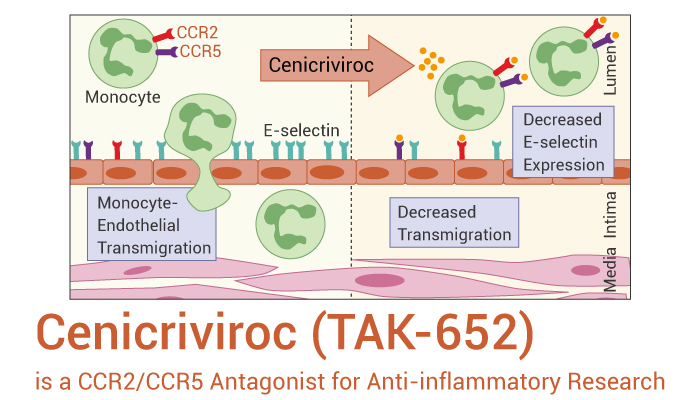CCR (Chemokine receptors) are cytokine receptors that interact with a type of cytokine called achemokine. The chemokine system mediates acute inflammation by driving leukocyte migration to damaged or infected tissues. Following interaction with their specific chemokine ligands, chemokine receptors trigger a flux in intracellular calcium (Ca2+) ions (calcium signaling). This causes cell responses, including the onset of a process known as chemotaxis that traffics the cell to a desired location within the organism. Therefore, the chemokine system is a key regulator of leukocyte trafficking during immune and inflammatory responses. Alterations of chemokines and their receptors have been described in pathological processes, including inflammatory and autoimmune diseases, transplant rejection, tumor growth, and metastasis. In addition, some pathogens can interfere with the host chemokines/chemokine receptors network either for host cell entry or for promoting their own survival.
CCR5 and CCR2 are structurally related chemokine receptors whose genes share significant sequence homology (73%). CCR2 is mainly pro-inflammatory, but anti-inflammatory roles in particular cell types such as regulatory T lymphocytes. CCR5 and CCR2 are key players in the trafficking of lymphocytes and monocytes/macrophages and have been implicated in the pathophysiology of a number of diseases, including viral infections and complex disorders with an inflammatory component. Accordingly, genetic polymorphisms in their coding or regulatory regions, which affect receptor expression or function, have been shown to influence the incidence and/or the course of HIV infection and inflammatory diseases.

Cenicriviroc (TAK-652) is a novel, orally administered, chemokine receptor type 2 and 5 antagonist
Cenicriviroc shows antifibrotic potential in preclinical and phase IIb studies of nonalcoholic steatohepatitis (NASH). Besides, Cenicriviroc also inhibits both HIV-1 and HIV-2, and displays potent anti-inflammatory and antinfective activity. Importantly, Cenicriviroc prevents human immunodeficiency virus type 1 (HIV-1) from cellular entry. Cenicriviroc significantly reduces monocyte/macrophage recruitment in vivo. Besides, Cenicriviroc shows antifibrotic effects, with significant reductions in collagen deposition, and collagen type 1 protein and mRNA expression across the three animal models of fibrosis. In the NASH model, Cenicriviroc significantly reduces the non-alcoholic fatty liver disease activity score. Cenicriviroc treatment has no notable effect on body or liver/kidney weight.
All in all, Cenicriviroc is an orally active, dual CCR2/CCR5 antagonist that displays potent anti-inflammatory and antiinfective activity.
References:
[1] Fantuzzi L, et, al. Cell Mol Life Sci. 2019 Dec;76(24):4869-4886.
[2] Anstee QM, et, al. Clin Gastroenterol Hepatol. 2023 Apr 13:S1542-3565(23)00273-2.